-
The reproductive cells which unite to initiate the development of a new individual are known as
gametes
-
Female gamete
ova
-
Male gamete
spermatozoa
-
The gametes themselves and the cells that give rise to them constitute the individual’s ________
Important because it constitutes the hereditary endowment passed from one generation to the next
germ plasm
-
Other cells in the body that take no direct part in the production of gametes
Regarded as the material that protects and nourishes the germ plasm
somatic cells (collectively known as somatoplasm)
-
It is a broad term that refers to the processes by which germ plasm is converted into highly specialized sex cells that are capable of uniting at fertilization and producing a new being
gametogenesis
-
Female gametogenesis
Oogenesis
-
Male gametogenesis
Spermatogenesis
-
1. Origin of the germ cells and their migration to the gonads
2. Multiplication of germ cells in the gonads through mitosis
3. Reduction of the number of chromosomes by 1/2 by meiosis
4. Final stages of maturation and differentiation of the gametes into spermatozoa or ova
Major phases of gametogenesis
-
In frogs and a number of invertebrate species, ________ can be recognized very early in the life of an individual—sometimes as regions in the vegetal pole cytoplasm of the zygote or as specific cells during the cleavage stages
germ plasm
-
_____________ of this region in frog embryos results in the development of an embryo lacking germ cells
Ultraviolet irradiation
-
Primordial germ cells of birds, reptiles, and mammals arise in the _____ of the early embryo and then take up temporary residence in extraembryonic tissues before returning to the body of the embryo proper
epiblast
-
In birds, they are recognizable in the __________, which is located well beyond the future head region of the embryo
germinal crescent
-
In mammals, primordial germ cells can be found in the posterior wall of the ____ near the origin of the allantois
yolk sac
-
Urodele amphibians (salamanders) are unique in that primordial germ cells arise from _____________ which form through the inductive influence of the ventral endodermal yolk mass on the overlying surface layer of cells
Mode of origin is different from frogs (anurans) and other higher vertebrates that Nieuwkoop and Sutasurya used as the principal basis for proposing that the urodeles have a phylogenetic origin separate from that of the anuran amphibians
embryonic mesodermal cells
-
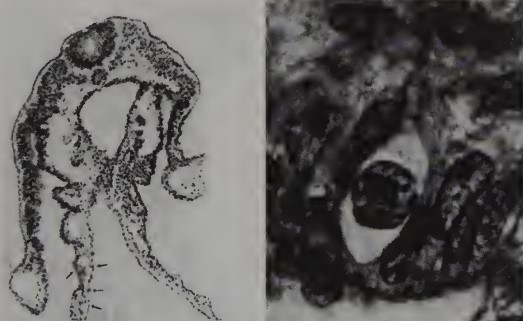
Regardless of their origin, primordial germ cells are usually readily recognizable because of their _______ and by certain histochemical characteristics, such as high alkaline phosphatase activity in mammals and a high glycogen content in birds.
In addition to these classical markers, monoclonal antibodies specific for primordial germ cells have been developed in both birds and mammals
large size and clear cytoplasm
-
When primordial germ cells are first recognizable in embryos, the _____ are either very poorly developed or not developed at all
gonads
-
One method of determining the fact that cells ultimately colonize the gonads; Willier did this in the chick and found gonads without gametes
Extirpate (eradicate) the areas in which these cells are first found
-
Another way of determining the fact that cells ultimately colonize the gonads; Take advantage of the unique characteristics of the primordial germ cells and ______
Directly trace their migration into the gonads
-
Another way of determining the fact that cells ultimately colonize the gonads; Using histochemical staining for alkaline phosphatase, Mintz and Russell (1957) showed that only small numbers of primordial germ cells were present in the mutant embryos
Mutant strain of sterile mice
-
In ______, they pass through the walls of local blood vessels and enter the circulation
From the bloodstream, they are apparently able to recognize the blood vessels of the gonads because there they penetrate the walls of the blood vessels and settle down in the gonads
birds and reptiles
-
In ______, primordial germ cells reach the gonads by migration around the wall of the posterior gut and then through the dorsal mesentery
It has been suggested that their active migration through the dorsal mesentery is guided by the orientation of extracellular matrix molecules, such as laminin and fibronectin, within the mesentery
mammals
-
Primordial germ cells occasionally make their way to extragonadal sites. Typically they die, but occasionally they develop into _______, which are bizarre tumors containing scrambled mixtures of highly differentiated tissues, sometimes including hair and teeth
teratomas
-
These are initially populated by a relatively small number (several thousand) of migrating primordial germ cells
embryonic gonads
-
The germ cells enter a proliferative phase once settled in the gonads in which their numbers increase greatly by means of ________
mitosis
-
Mitotically active germ cells in the female
oogonia
-
Mitotically active germ cells in the male
spermatogonia
-
Natural degeneration
atresia
-
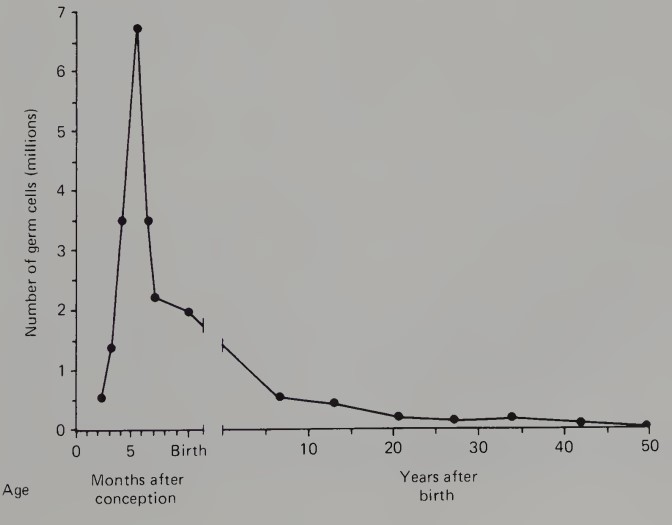
In the human female, intense mitotic activity between the second and fifth months of pregnancy brings the population of oogonia from a few thousand to about 7 million.
The number of oogonia then falls sharply, mainly because of atresia (natural degeneration), and by the seventh month most of the oogonia have entered the prophase of their first meiotic division, becoming primary oocytes.
female proliferative phase of gametogenesis
-
Populations of oogonia in many ______________ are capable of dividing throughout the reproductive life cycle.
When one considers that some fishes release several hundred thousand eggs at one spawning, the need for the mitotic capability of oogonia throughout life is understandable
nonmammalian vertebrates
-
In rodents, mitosis continues in the gonad of the early embryo, but it then ceases during the later days of pregnancy, only to resume after birth. The ________ always retains a germinative population of spermatogonia.
Beginning at puberty, periodic waves of mitosis produce subpopulations of spermatocytes that enter meiosis as synchronous groups. This activity continues as long as the male is capable of reproduction
testes
-
One of the fundamental requirements in the sexual reproduction of any species is that the normal number of chromosomes must be maintained from one generation to another.
This is accomplished by the reduction of the chromosomal complement of the gametes from the _________ condition during gametogenesis
diploid (2n) to haploid (In)
-
A major requirement of meiosis is that _____________. Yet meiosis is the phase during which new combinations of genetic material, some arising from maternal genes and others from paternal genes, are assembled
each haploid gamete must acquire a complete set of chromosomes
-
Occurs by (1) the random distribution of maternal or paternal chromosomes to the daughter cells and (2) the exchanging of portions of homologous chromosomes by crossing over at specific phases of meiosis
genetic recombination
-
Why does meiosis not involve DNA synthesis?
When meiotic prophase begins, DNA replication in the gamete has already taken place
-
At the beginning of meiosis, the cell can be described as 2n 4c, meaning
cell contains 2n (normal) chromosomes and 4c (double) DNA content due to replication
-
The object of meiosis is to produce haploid gametes with a
1c-1n complement of genetic material
-
Choose the correct statement:
A: The reduction of genetic material involves two maturation divisions in which new DNA synthesis does not occur.
B: The reduction of genetic material involves two maturation divisions in which new DNA synthesis occurs.
A: The reduction of genetic material involves two maturation divisions in which new DNA synthesis does not occur.
-
The first meiotic division, sometimes called the __________, results in the formation of two genetically dissimilar daughter cells (In, 2c).
reductional division
-
The second, or _______, meiotic division each of the previous two cells produces two genetically identical daughter cells (1n, 1c) that can now be properly called gametes
equational division
-
Mitosis: minutes of hours; Meiosis: _________
several days to as long as 45-50 years
-
1. Prophase I
a. Leptotene
b. Zygotene
c. Pachytene
d. Diplotene
e. Diakinesis
2. Metaphase I
3. Anaphase I
4. Telophase I and Interphase
first meiotic division
-
1. Prophase II
2. Metaphase II
3. Anaphase II
4. Telophase II
(like ordinary mitotic division)
second meiotic division
-
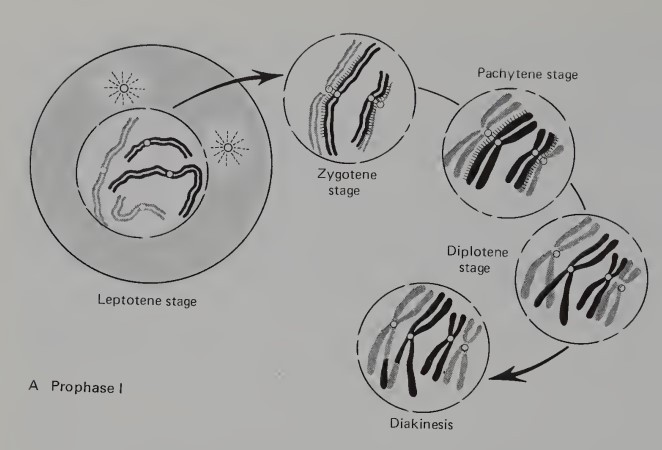
A complex stage that is usually divided into five substages: leptotene, zygotene, pachytene, diplotene, and diakinesis
Prophase I
-
The chromosomes are threadlike and are just beginning to coil. Each chromosomal thread actually consists of two identical sister chromatids, which are joined somewhere along their length by a common centromere.
One of the chromatids is an original DNA strand, whereas the other was newly synthesized just before the start of meiosis. It is usually not possible to resolve the individual chromatids by standard light microscopy
Prophase I: Leptotene Stage
-
The period during which the homologous paired chromosomes (one set of sister chromatids from the maternal side and one set from the paternal side) come together and become closely apposed along their entire length on a point-for-point basis
Prophase I: Zygotene Stage
-
Precise lining up that forms the basis for the crossing over of genetic material that occurs later in the first meiotic division
synapsis
-
The area of contact between the paired chromosomes has a specialized ultrastructure involved in the pairing up and possibly in the crossing-over of chromosomes
synaptinemal complex
-
During the early ________ synapsis is completed; the two aligned chromosomal pairs are collectively referred to as a bivalent.
A prominent feature of this stage is the thickening of the chromosomes owing to their coiling. Within a single chromosome, the sister chromatids appear to be held together by a centromere
Prophase I: Pachytene Stage
-
Late in the pachytene stage and during the _____ portions of the paired chromosomes overlap one another.
A major feature of this stage is the separation of the two paired chromosomes by splitting along the synaptinemal complex.
The splitting occurs along most of the length of the chromosomes but not at the chiasmata, which are now well-defined. The individual chromatids are also clearly visible by this time, and it can be seen that each bivalent consists of four distinct chromatids. It can now be called a tetrad.
During this stage, the chromatids uncoil slightly, and in eggs, at least, RNA synthesis occurs in areas of uncoiling
Prophase I: Diplotene Stage
-
In this stage, the chromosomes shorten even more. The splitting of the chromosome pairs continues, and one component of the splitting process that is characteristic of this stage is the moving of the chiasmata toward the ends of the chromosomes.
At this point the nucleolus disappears, the nuclear membrane breaks, and the spindle apparatus becomes apparent
Prophase I: Diakinesis Stage
-
The moving of the chiasmata toward the ends of the chromosomes
terminalization
-
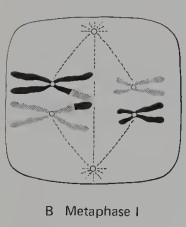
The tetrads line up along the metaphase plate so that for each chromosome pair, the maternal chromosome is on one side of the equatorial plate and the paternal chromosome is on the other.
The alignment of chromosomes is randomly distributed (maternal and paternal) on both sides of the equator, forming the basis for Mendel's second law of heredity
Metaphase I
-
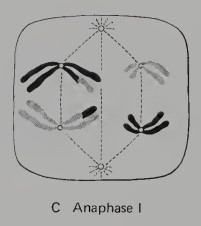
At this point, the individual paired chromosomes begin to move toward opposite poles of the spindle. Both sister chromatids of each chromosome continue to be held together by the centromere.
As the homologous chromosomes move away from one another, the chiasmata, which have moved to the ends of the chromosomes, are pulled apart and crossing-over is complete.
The migration of the entire maternal chromosome to one pole and the paternal chromosome to the other pole during meiosis results in genetically unequal daughter cells
Anaphase I
-
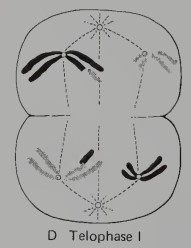
The two daughter nuclei are separated from each other and nuclear membranes may re-form.
Nucleus - haploid no. of chromosomes (1n)
Chromosome - two sister chromatids connected by a centromere (2c)
Since the individual chromosomes of the haploid daughter cells are still in the replicated condition, there is no new replication of chromosomal DNA during the interphase between meiotic division I and meiotic division II.
Telophase I
-
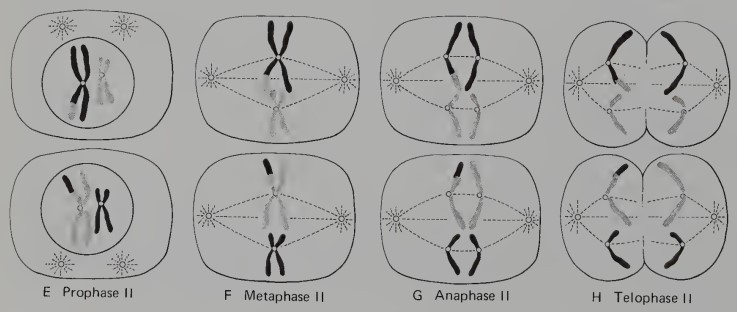
Except for the fact that the cell is haploid (1n, 2c), this is like an ordinary mitotic division. After an atypical prophase, a mitotic spindle apparatus is set up and the chromosomes line up along the equatorial plate at metaphase II. Then, in contrast to the first meiotic division but similar to a mitotic division, the centromere between the sister chromatid of each chromosome divides, allowing the sister chromatids to separate from each other during anaphase. With the completion of telophase II, meiosis is complete and the original diploid germ cell has produced four haploid daughter cells (1n, 1c).
Second Meiotic Division
-

major events in human oogenesis
-
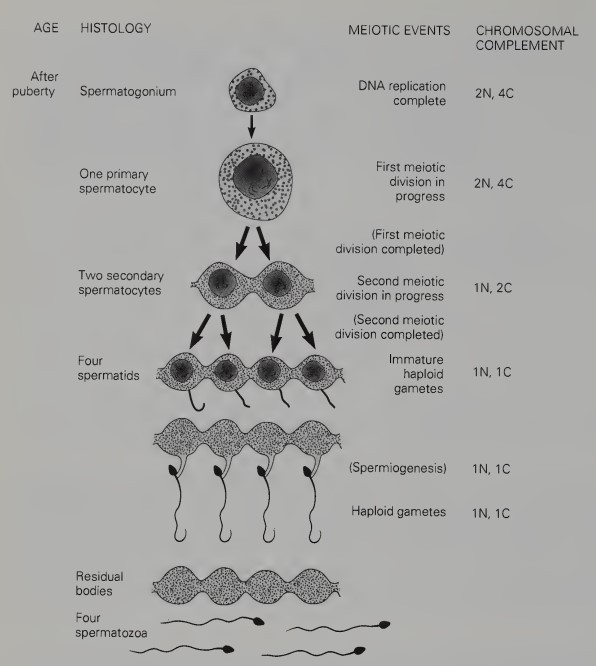
major events in human spermatogenesis
-
In contrast to spermatogonia, each of which gives rise to four functional spermatozoa as the result of two meiotic divisions, an oogonium produces _____.
one viable ovum
-
After the first meiotic division one cell is left with the bulk of the cytoplasmic material, whereas the other, called the _________, is left with little cytoplasm. The polar body often degenerates without taking part in the second meiotic division
first polar body
-
During the second meiotic division, the cytoplasm is also unequally apportioned between the daughter cells, and the ovum retains the bulk of the cytoplasm, leaving the other cell to fall by the wayside as the _______.
second polar body
-
Human Female: Meiosis I begins in the embryo and meiosis isn't completed until the onset of puberty-menopause
Human Male: ___________
Spermatogenesis does not begin until puberty but is continuous throughout life; complete after approx. 2 months; no prolonged meiotic arrests
-
Although there is considerable interspecies variation, especially among the invertebrates, it is common for an ______ to experience two periods of meiotic arrest
egg
-
First period of meiotic arrest in eggs occur during Prophase I, specifically in the _____. This allows the egg to build up its stores of yolk and to prepare for the synthetic activity that occurs after fertilization
Can be prolonged up to 40 years; often broken by hormonal changes and meiosis resumes only to be arrested again
diplotene phase
-
The second arrest is released with fertilization or ___________. Some eggs, e.g., those of the sea urchin, undergo completion of the second meiotic division before they are shed
This occurs in Metaphase II in vertebrates
artificial activation of the egg
-
Although all phases of meiosis do not occur at the same rate during spermatogenesis, prolonged periods of meiotic arrest are not the rule.
A general rule is that if the second meiotic division in eggs (or sperm) is completed before fertilization, ____________________
no further DNA synthesis will occur until the egg and sperm have met
-
During development, the egg stores both energy sources and precursors of proteins and nucleic acids. Sperm cells, by contrast, shed most of their cytoplasm and must rely on the _________ as an energy source.
seminal fluid
-
In anticipation of future requirements, the egg produces and stores up much RNA, whereas ________ occurs during the later stages of spermatogenesis
little or no RNA synthesis
-
The transition from mitotically active primordial germ cells to mature spermatozoa involves a series of structural transformations. It can be broken down into 3 principal phases:
1. mitotic multiplication
2. meiosis
3. spermiogenesis
spermatogenesis
-
Mitosis of sperm-forming cells occurs throughout life, and the mitotically active cells within the seminiferous tubules are known as ______. These cells are concentrated near the outer wall of the seminiferous tubules
spermatogonia
-
1. Type-A Spermatogonia - stem-cell population
2. Type-B Spermatogonia - rises from mitotically pale A cells
main populations of spermatogonia
-
Within this population is a group of noncycling dark A cells that may be long-term reserve cells. Some of these cells become mitotically active pale A cells, which ultimately give rise to type-B spermatogonia
Type-A Spermatogonia
-
These are cells that have become committed to leaving the mitotic cycle and which go on to finish the process of spermatogenesis. After the final round of DNA duplication, the type-B cells are called __________ and are ready to pass through the meiotic phase of spermatogenesis.
preleptotene spermatocytes
-
With the onset of the second meiotic division, these cells are known as ______.
In humans, the first meiotic division lasts for several weeks, whereas the second one is completed in about 8 hours. Four haploid spermatids result from the meiotic phase of spermatogenesis
secondary spermatocytes
-
Although they no longer divide, the spermatids undergo a profound transformation from relatively ordinary-looking cells to extremely specialized spermatozoa. The third phase in spermatogenesis is called ______, or spermatid metamorphosis
spermiogenesis
-
1. Finely granular chromatin and reconstituted nuclear membrane
2. Compacted chromatin constitute the bulk of the head of the spermatozoon
3. Cell organization changes - formation of sperm head and acrosome
4. Flagellum anchors on centrioles
5. Mitochondria begins to form a spiral investment around flagellum
6. Remaining cytoplasm becomes a remnant or residual body that is sloughed off and phagocytized by the Sertoli cells
radical changes in the metamorphosis of a spermatid
-
(1) a head containing the nucleus and acrosome,
(2) a neck containing the proximal centriole;
(3) a middle piece containing the proximal part of the flagellum, the centrioles, and the mitochondrial helix, which acts as an energy source; and (4) the tail, a highly specialized flagellum
parts of a mature spermatozoon
-
As early as the mitotic divisions of the type-A spermatogonia, the daughter cells are connected to one another by fine intercellular bridges of cytoplasm that are the result of _________ (cell division) after mitosis
incomplete cytokinesis
-
(1) being the target cells for FSH,
(2) synthesizing of an androgen-binding protein that maintains a high concentration of testosterone inside the seminiferous tubule,
(3) maintaining the blood-testis barrier,
(4) creating an environment that is important in the differentiation of sperm cells,
(5) facilitating the release of mature spermatozoa, and
(6) degrading the residual cytoplasm that is shed during spermiogenesis
Sertoli cells
-
The blood-testis barrier consists of a continuously interlocking sheet of Sertoli cell processes, which are attached to one another by tight junctions. Why is it necessary?
To prevent the body’s immune system from destroying the maturing sperm cells, which are antigenically different from the rest of the body
-
Spermatocytes in the __________ of meiosis pass through the blood-testis barrier. Passage through the barrier is accomplished by the Sertoli cells’ extending processes and forming an impermeable layer on the outer side of the leptotene spermatocytes. Concurrently, the original Sertoli-cell barrier on the inner side of the cells is disrupted as the Sertoli cells withdraw these processes
zygotene stage
-
To produce the appropriate messenger RNAs at an early stage, store them in an inactive form, and then, when needed, release the mRNA molecules that are used to form the needed proteins. This strategy involves what is often called
posttranscriptional control
-
A final phase of sperm maturation in the male reproductive tract might better be called _____, after ejaculated spermatozoa have come into contact with the seminal fluid secreted by the seminal vesicle and prostate gland. The seminal fluid provides the functionally mature sperm with an external energy source which allows it to gain full motility
activation
-
The ova of mammals are very small, because it is not necessary to store in advance large amounts of yolk and other materials needed for development of the embryo. In contrast, the ova of animals developing _____ are often quite large, since they contain within them the yolky materials needed for the embryo’s development.
outside the body
-
In amphibians, the mitotic phase of oogenesis does not come to an early halt as it does in mammals. Rather, each year a new crop of eggs is generated by __________ from a population of gametogenic stem cells. The maturation of frog (Rana pipiens) eggs requires 3 years. The first batch of eggs begins to mature shortly after metamorphosis.
mitotic proliferation
-
Within the amphibian ovary, the eggs are arranged in individual follicles. They are surrounded first by a layer of follicular epithelium, next by a ____ (a thin layer of ovarian connective tissue containing blood vessels), and then by a layer of ovarian epithelium
theca
-
1. Previtellogenic Phase - before the deposition of yolk
2. Vitellogenesis Phase - major period of yolk deposition
3. Final Maturation - oocyte is released from meiotic block through progesterone
Phases of Amphibian Egg Development
-
Includes the period up to the early diplotene phase of meiosis; becomes a site of intense synthetic activity
previtellogenic phase
-
The enlarged nucleus of the amphibian egg
germinal vesicle
-
The early diplotene nucleus is also characterized by the formation of large numbers of nucleoli (up to 1500 in Xenopus), which soon become distributed beneath the nuclear membrane. These nucleoli are the morphological expression of a phenomenon known as
specific gene amplification
-
The _________ is the principal structure involved in the synthesis of high-molecular-weight rRNAs and the assembly of ribosomes
nucleolus
-
Main feature of the vitellogenic phase
formation of yolk
-
A collective term for several classes of chemical substances which are stored in the cytoplasm to provide nutrition for the developing embryo
yolk
-
In the amphibian egg, proteinaceous material is stored in the form of membrane-bound _____, lipid is stored as inclusions called lipochondria, and carbohydrate is accumulated as aggregates of glycogen granules
yolk platelets
-
The yolk precursor in the blood is a phospholipoprotein called
________, which actually represents a family of proteins.
This material is cleared from the blood in the ovary and must pass through the follicular epithelium to reach the egg. Since this is too large for a molecule to pass through the plasma membrane of the oocyte by diffusion, it is incorporated into the oocyte by the process of micropinocytosis
vitellogenin
-
Vitellogenin cannot be detected within the mature oocyte. Instead, the protein yolk is represented by two molecules; ________, a protein (MW 35,000) with a high phosphorus content, and _________, a lipoprotein (MW -400,000). These two proteins are packed in crystalline form within a membrane to form the yolk platelets.
phosphovitin; lipovitellin
-
These are membrane-bound inclusions composed principally of protein and mucopolysaccharide material. These structures have an irregular distribution throughout the animal kingdom. For instance, they are found in the eggs of sea urchins, frogs, and humans but not in those of salamanders.
cortical granules
-
Arising later during oogenesis than the other inclusions, the pigment granules are concentrated in the half of the egg known as the
animal hemisphere
-
The less heavily pigmented but more yolk-laden half is known as the
vegetal hemisphere
-
The transitional zone between these two hemispheres is commonly known as the
marginal zone

